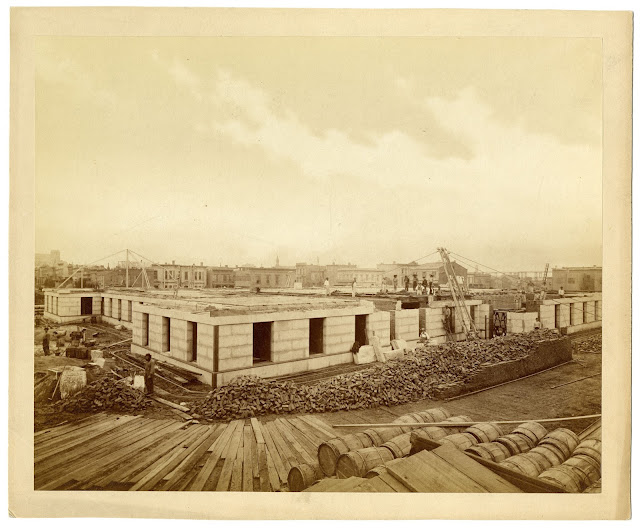 |
Modoc Chief Kintpuash (“Captain Jack”) in 1864
Creative Commons
|
As
Native American Heritage Month draws to a close, so, too, do our related
exhibitions, Sensational Portrayals of the Modoc War, 1872–73 and Native Portraits: Contemporary Tintypes by Ed Drew.
The Modoc War connects these two shows: one features the intense interest the
war created throughout the United States and the other displays contemporary
portraits of native peoples of the Klamath region—some of them descendants of
those who fought in the war.
This blog post commemorates a hero of the Modoc War, Kintpuash, known as Captain Jack (1837–1873).
In 1872–73, this Modoc resistance leader led
his people from the confines of the Klamath Indian Reservation back to their
homeland to fight for the right to live as free people on their ancestral land
in the Tule Lake area of northern California.
Klamath Indian Reservation, 1879
US Bureau of Reclamation, Klamath Basin Office
|
The Klamath Indian Reservation had its beginnings in the Treaty of
1864, in which the Klamath, Modoc, and Yahooskin peoples agreed
to live together as what was referred to as the “Klamath Tribe” on a reservation
in the Klamath Basin of southern Oregon. In exchange for their land—almost 20 million
acres—they would be provided necessary provisions on land about one-tenth the
size.
 |
Klamath and Modoc Territories and Subgroups in the 19th Century with Modern Town Locations
Courtesy College of the Siskiyous
|
In the annals of the militarization of the West in the nineteenth
century, many promises were made by the federal government, and many were not
honored. For one band of Modoc Indians living in the Klamath Reservation the
arrangement became untenable.
After a number of years without help and provisions, and under the
leadership of Kintpuash with Jim Schonchin, a small group of Modoc men and their families left
the reservation and returned to their ancestral lands in today’s Lava Beds
National Monument in northern California. Federal troops attempted to push them
back to the reservation. As Indian Commissioner
Thomas J. Morgan, acknowledged about the government’s long-standing policy,
“The Indians must conform to ‘the white man’s ways,’ peaceably if they will,
forcibly if they must.” But the
Modocs refused to abandon their homeland.
Louis H. Heller, Modoc Leaders Jim Schonchin and Captain Jack, 1873
California Historical Society
|
 |
Louis H. Heller, Captain Jack’s Family, 1873
California Historical Society
|
War
erupted in November 1872 between the Modocs—about 55 men and their families—and
the United States Army. The volcanic landscape of the 47,000-acre lava beds
(called the Land of Burnt Out Fires), with its nearly 700 caves, became a
natural fortress that the Modocs reinforced to give them an upper hand in
battles.
Eadweard
Muybridge, The Lava Beds, 1872–73
California
Historical Society
In
January 1873, as U.S. troops from Fort Vancouver and Fort Klamath pressed the
first major assault on Captain Jack’s Stronghold (the Modoc fortress), fog
rolled in from nearby Tule Lake, blinding the soldiers as they inched across
the rocky terrain. The Modocs moved unseen through lava tubes, killing or
wounding dozens of soldiers from below while suffering no casualties of their
own.
For
about six months, the Modocs successfully fought off U.S. troops, capturing the
attention and imagination of people across the country, many of whom were
sympathetic to the Modocs for humanitarian reasons.
Captain
Jack himself became somewhat of a folk hero. He was then “a man of 30 years of
age, a man of square mold, 5 feet, 10 inches in height—a royal-blooded man of
more than common heritage,” observed Col. Alfred B. Meacham of the Bureau of
Indian Affairs.
According
to the May 30, 1873, issue of the New
York Times, “Each mail brings also to camp an extensive correspondence for
Capt. Jack . . . . One wishes Jack to come there and scalp the fellow who wants
to win his girl away from him, another assures him he will get plenty of
volunteers if he comes to his village, still again he is congratulated on his
heroism and told to go on and conquer.”
But
the adulation was short-lived. On April 11, 1873, the Army and Modocs held a
peace commission. In his bid for a settlement, Captain Jack requested a
reservation of 6 square miles on the lava beds. Indians could live there, he
reasoned, white men couldn’t. When it became clear that the two sides would not
come to terms, Captain Jack opened fire and a battle ensued, resulting in the
deaths of General Edward R. S. Canby—the only U.S. general lost in an Indian
conflict—and Reverend Eleazer Thomas.
With
the tide now turned against the Modocs, the government renewed its attempts to
drive the Modocs out of the lava beds. Joined by 70 Warm Springs Indian scouts,
675 U.S. soldiers with four batteries of artillery besieged Captain Jack’s
Stronghold for two days, but as few as eight Modoc men continued to fend them
off.
 |
Eadweard Muybridge, Warm Springs Indian Scouts in Camp, 1872–73
California Historical Society
|
 |
Add captioEadweard Muybridge, The Modoc Stronghold after Its Capture, 1872–73
California Historical Society
|
The
Modocs were nevertheless driven from their advantageous position. A loss of
morale led several men to desert Captain Jack and help the forces hunting him.
It was not until the first of June, a remarkable six months after the conflict
began, that Captain Jack and his closest allies finally surrendered. They were
brought to Fort Klamath, where they were sentenced to death for the murders of General
Canby and Reverend Thomas.
 |
Fort Klamath Graves of Boston Charley, Black Jim, John [Schonchin] Schonchiss, and Captain Jack, Executed October 3, 1873
Courtesy Huntington Library, San Marino, California
|
Shelly
Kale
Publications
and Strategic Projects Manager
Sources
Boyd Cothran, Remembering
the Modoc War: Redemptive Violence and the Making of American Innocence
(Chapel Hill: The University of North Carolina Press)
Cheewa James, The
Tribe That Wouldn’t Die (Happy Camp, CA: Naturegraph Publishers, 2008)
______________________________________________________________________________
Closing Soon!











































